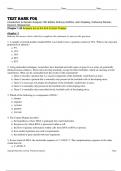Exam (elaborations)
Test Bank For Introduction to Genetic Analysis 12th Edition by Anthony Griffiths; John Doebley; Catherine Peichel; David A. Wassarman Chapter 1-20
- Course
- Institution
- Book
Test Bank For Introduction to Genetic Analysis 12th Edition by Anthony Griffiths; John Doebley; Catherine Peichel; David A. Wassarman Chapter 1-20
[Show more]



